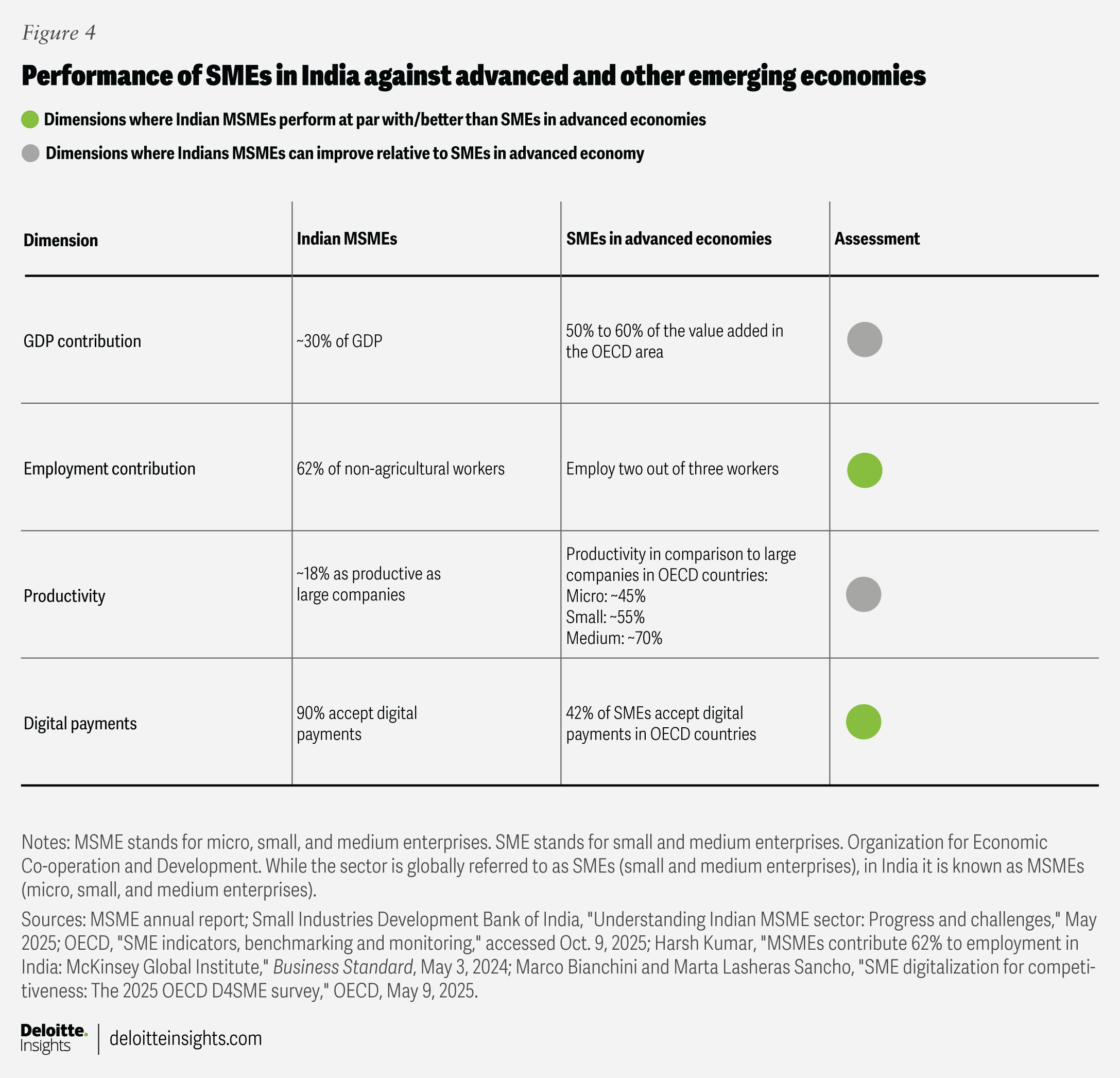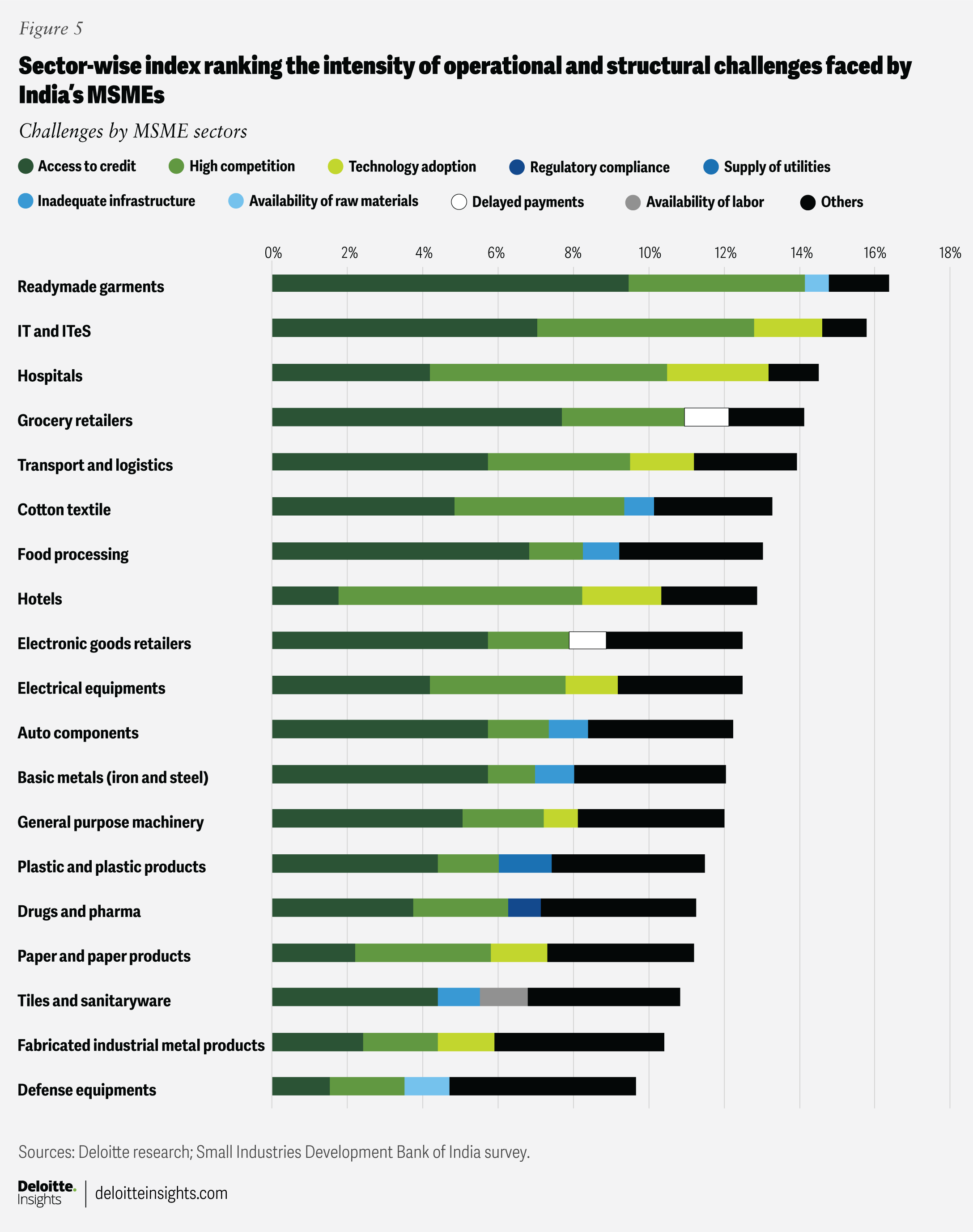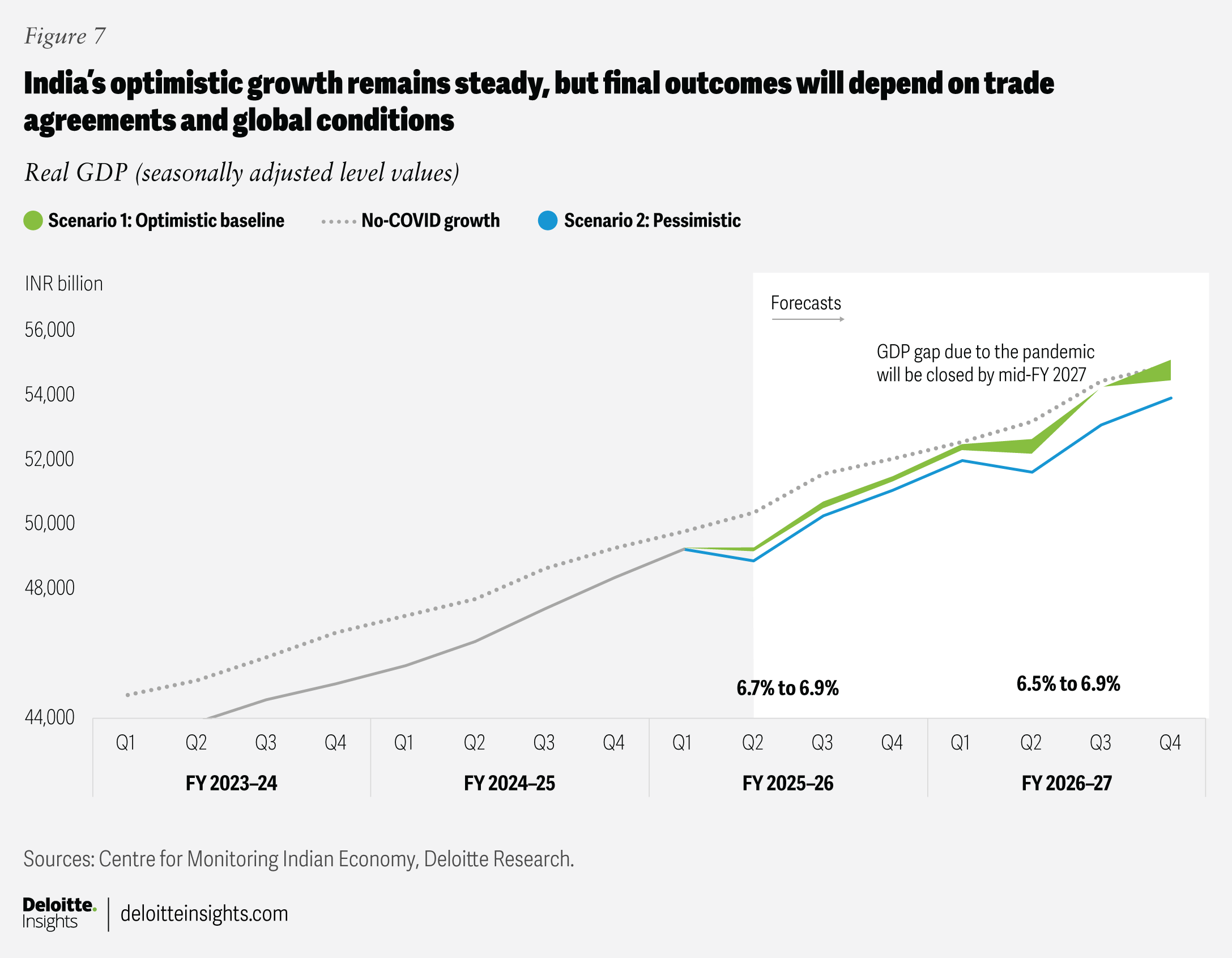India economic outlook, October 2025
Robust domestic demand and ongoing structural reforms are bolstering growth resilience. The next step is to empower micro, small, and medium enterprises to harness this momentum.
India’s strong GDP growth at the very start of fiscal year 2025 to 2026 underscores the resilience of its macroeconomic fundamentals and sets a positive tone for the months ahead. Deloitte projects baseline (optimistic) economic growth of 6.7% to 6.9% this fiscal year and 6.5% to 6.9% the following fiscal, supported by direct income tax exemptions, continued goods and services tax (GST) reforms, an accommodative monetary policy, and a possible trade deal with the United States.
This edition of the India economic outlook focuses on micro, small, and medium enterprises (MSMEs), which remain critical to India’s gross domestic product, employment, manufacturing, and exports. Despite their scale and contribution, MSMEs in India face a persistent productivity gap that constrains their competitiveness.
Our analysis explores Indian MSMEs’ global standing and the various structural challenges that determine MSME competitiveness across different sectors. State-wise MSME performance comparisons suggest strengthening MSMEs through targeted policy reforms, deeper digital adoption, an inclusive financial ecosystem, and increased infrastructure investment helps them differentiate themselves and is critical to sustaining broad-based growth, particularly in tier 2 and tier 3 cities where these enterprises are most concentrated.
India’s economy starts the fiscal year on a strong footing
India’s GDP grew 7.8% year over year in the April to June quarter of fiscal 2025 and 2026—a sharp improvement from the muted growth seen in the same period last year and well above market expectations.
- Private consumption rose 7%, supported by tax cuts that boosted disposable incomes. Retail sales grew 6.8% through July, while fast-moving consumer goods volumes surged 13.9% in the second quarter of 2025. Government spending also rebounded, growing 7.5% after last year’s contraction, aided by early disbursement of funds and higher allocations.
- Investment activity remained healthy, with gross fixed capital formation rising 7.8%, driven by a significant uptick in government capex, which reached 24.5% of budget estimates in the first quarter, compared with just 16.3% last year. This acceleration signals renewed confidence in infrastructure-led growth.
- External trade gained momentum, with exports growing 6.3%, supported by strong demand from key markets such as the United States, despite global trade headwinds. Purchasing Managers’ Index data in April showed export orders surging at the second-fastest pace in over 14 years.
- Gross value added grew 7.6%, with agriculture rebounding to 3.7% on the back of good monsoons and higher reservoir levels. The secondary sector expanded 7%, led by manufacturing (7.7%), while construction moderated to 7.6% due to the early monsoon. Services remained the key growth engine, expanding 9.3%, the fastest in two years, driven by strong momentum in trade, financial services, and public administration.
Looking ahead, this is likely to be one of the strongest quarters of the year. While higher US tariffs could weigh on exports and manufacturing in subsequent quarters, domestic demand should continue to drive growth, supported by easing inflation, GST rationalization, and continued policy support.
MSMEs: The bedrock for broad-based growth
Indian MSMEs have long shaped the country’s growth trajectory. They form the foundation on which India’s industrial and services sectors stand. Their role extends well beyond supporting large enterprises: MSMEs are where jobs are created at scale, exports are diversified, and innovation often begins.
Today, they account for nearly 30% of GDP, contribute 45% of exports, and provide livelihoods to over 240 million people, underscoring their central role in India’s economic fabric (figure 1). Deeply embedded across industries, MSMEs drive a significant share of India’s engineering goods (20%), gems and jewelry (12%), and textiles (9%) exports (figure 1).

Given its importance, the sector has always been at the center of various policy reforms and initiatives. Recent efforts have emphasized formalization and scaling, as a large share of the sector still operates informally. These efforts have spurred a surge in online MSME registrations with the government (Udyam registration portal), bringing more enterprises into the financial and regulatory fold. Improved access to credit, markets, and government support have also helped MSMEs move up the value chain (evident in their growing export contribution to sectors such as engineering and chemicals) and scale up their operations (with around 50,000 such firms transitioning to medium enterprises over the past four years) (figure 2).

How India’s MSMEs compare: A global perspective
The importance of MSMEs to India’s growth and employment is, however, not unique. Across major economies, MSMEs remain vital drivers of innovation, job creation, and economic expansion (figure 3).
In the United States, these companies have seen considerable growth. By 2023, approximately 17% of publicly traded companies (valued at US$10 billion or more) started as MSMEs in the past two decades. China’s rise to power as the second-largest economy in the world between 1980 and 2010 was not driven by state-owned giants alone. In fact, by 2012, small and medium enterprises (SMEs) became the backbone of China’s export engine and manufacturing growth, making up over 98% of industrial enterprises.

While MSMEs are vital to India’s economy, their contribution to GDP and jobs remains significantly lower than in advanced economies (figure 4). The core issue is productivity. In countries within the Organisation for Economic Co-operation and Development, MSMEs function at 45% to 70%1 of large-enterprise productivity compared with only about 18%2 in India (figure 4).

The productivity levels of Indian MSMEs, according to a World Bank report, are constrained by structural bottlenecks such as limited access to finance, outdated technology, and weak integration into global value chains. These result in inefficient resource utilization and higher operational costs, reducing competitiveness in both domestic and international markets. The World Bank also emphasizes that improving productivity through digital adoption, skill development, and better infrastructure is critical for unlocking the sector’s growth potential.3
Encouragingly, India leads in digital readiness, with MSMEs embracing digital payments at a scale unmatched by many OECD peers, positioning them well for e-commerce and fintech-driven growth (figure 4). Recent trends, such as credit expansion, record online registrations, and rising export participation (figures 1 and 2), suggest the sector is likely witnessing a transformative shift.
Challenges facing India’s MSMEs
MSMEs’ stark productivity gap relative to their global peers remains a significant barrier to scaling, integrating into global value chains, and driving innovation at pace. A 2024 Small Industries Development Bank of India survey identifies three core challenges: access to long-term finance, intense competition, and technology adoption.
- Access to credit has long been the sector’s Achilles’ heel. Despite multiple policy interventions, many firms lack the collateral or credit history to secure formal financing, leaving them dependent on informal sources. The credit gap is estimated at ₹30 lakh crore—about 24% of total demand—while it is much higher for services (27%) and women-owned MSMEs (35%). These constraints continue to hinder scaling opportunities and modernization, while adding to costs and pressure margins.4
- Intense competition is particularly evident in sectors that are less capital-intensive and service-oriented with low entry barriers. Smaller firms struggle to compete with the scale and resources of larger players. Many are compelled to accept projects with thinner margins, limiting their ability to scale or expand their offerings.
- Technology adoption among MSMEs has been uneven. While approximately 90% of MSMEs now accept digital payments, only 18% have accessed digital lending platforms. The use of automation and advanced digital tools for operations and marketing remains limited.5
MSMEs also face systemic constraints, including weak infrastructure, underdeveloped ecosystems, restricted market linkages, raw material bottlenecks, and complex regulatory compliance requirements.6 The severity of these challenges varies by sector.
Figure 5 presents a sector-wise index, developed by Deloitte, ranking the extent to which different MSME segments are impacted by key operational challenges listed above.7

Readymade garments rank highest on the challenge index, due to severe credit constraints (with 43% intensity), followed by high competition and availability of raw materials. These make the sector highly vulnerable to working capital and supply chain disruptions, while intense global competition keeps their margins low and makes products highly substitutable.
The Information technology and information technology–enabled services sector follows closely, reflecting its struggle with the top three challenges listed earlier. Rapid technological change and high talent attrition further weaken MSMEs’ ability to compete globally, limiting their opportunities to scale. Hospitals and grocery retailers occupy similar positions on the index, showing moderate vulnerability to a broader range of challenges.
By contrast, defense equipment, fabricated metal products, and tiles and sanitaryware appear relatively resilient to challenges, possibly due to niche demand or government procurement support. However, they face unique challenges, particularly delayed payments and the shortage of skilled labor.
Increasing the productivity of MSMEs to top-quartile levels relative to large companies could add an equivalent of 10% to GDP in emerging economies.8 In India, these challenges sit at the core of productivity gaps, which continue to widen relative to other nations. Addressing these issues will require sector-specific interventions, capability building in services, logistics digitization, regulatory simplification, and greater process automation.
Sensitivity to US tariffs: Given that MSMEs in textiles and garments, auto components, and general-purpose machinery have the highest exposure to exports, they remain particularly vulnerable to the recent uncertainties emerging from US tariffs. Already constrained by limited access to capital and intense competition, MSMEs may need immediate and coordinated policy responses, such as extended credit lines, export insurance, and market diversification support to deal with external shocks.
India’s MSME hubs across Indian states
The MSME growth story in India extends beyond headline numbers. Unlocking their full potential requires addressing the structural asymmetries and challenges, which hinder not just productivity but also long-term resilience. For instance, Uttar Pradesh and West Bengal each account for 14% of India’s MSMEs, while Tamil Nadu contributes another 8%.9 Together, these three states comprise more than a third of the national total.
Yet, when we shift the lens to holistic growth, driven by formalization rates, credit access, employment generation, and digital adoption, the picture becomes far more nuanced. In fact, state-level disparities are stark.
Some states have taken a structured approach to MSME development by investing in infrastructure, fostering supportive ecosystems, and introducing targeted policies and schemes, including export facilitation. A state-wise analysis reveals sharp divergences in MSME performance, with states that combine robust infrastructure, proactive policy frameworks, and institutional support consistently outperforming their peers. This highlights the importance of an integrated ecosystem for sustainable MSME growth.10
Figure 6 presents a state-wise composite index, developed by Deloitte, ranking MSME resilience across four key dimensions: formalization, employment generation, credit uptake, and digital adoption. Maharashtra tops the index, serving as the benchmark against which other states are assessed. Uttar Pradesh, Tamil Nadu, and Karnataka follow closely, reflecting strong momentum in building resilient and scalable MSME growth.

The multidimensional investments by states in building a supportive ecosystem for MSMEs is the key differentiator. Findings from the India MSME Forum survey, which ranks states based on providing support to strengthen MSME ecosystems, align closely with Deloitte’s state-wise MSME index. This reinforces the insight that states performing well on formalization and digitization are also those that have invested strategically in infrastructure, targeted policies and schemes, and export and procurement facilitation.11
From policy to practice: Enabling MSMEs for sustainable growth
The findings above point to a broader imperative. While recent policy efforts have rightly focused on boosting domestic demand (through tax reforms, GST rationalization, and accommodative monetary policy), the next frontier is enhancing MSME productivity by focusing on four priorities. This will not only strengthen employment and consumption but also bolster export competitiveness in the face of global uncertainties.
Sectoral priorities: Policymakers will need to prioritize support for export-oriented sectors such as textiles, leather, gems, and jewelry (that are currently at most risk emanating from US tariffs). A critical part of this involves improving MSMEs’ access to finance. Initiatives like the Trade Receivables Discounting System are beginning to tokenize receivables and improve access to working capital. Credit assessment is also being strengthened using filed returns and GST data, but further progress is needed in leveraging MSMEs’ sales records, e-commerce transactions, and digital footprints. Additionally, credit-enhancement mechanisms and partial guarantee schemes will be essential to derisk lending, expand formal credit flows, and sustain MSME growth.
State-level imperatives: States will need to focus on the right mix of infrastructure, digital readiness, and tailored policy support to elevate MSME performance and build long-term resilience. Lagging states will need to intensify investment in industrial clusters, shared facilities, and logistics infrastructure, such as flatted factories, broadband, power, and connectivity infrastructure. At the same time, improving digital ecosystems (online presence, e-commerce, digital payments, digital governance) and skill development will remain essential. Policy measures should also expand access to finance via reforms that ease land and regulatory clearances, interest subsidies, cluster-based financing, and guarantee schemes.
Private sector opportunities in hinterlands: Simultaneously, solution providers and enablers must tap into the next wave of MSME transformation, which is likely to come from non-metro regions of certain states, where MSMEs are concentrated. Deeper digital adoption and a broad-based ecosystem development in tier 2 and tier 3 cities will unlock new opportunities to offer innovative and scalable services.
Role of artificial intelligence: AI can significantly accelerate MSME growth in India by enhancing productivity, improving market access through digital platforms, and enabling data-driven decision-making.
India’s near-term economic outlook
Under our optimistic scenario, India is projected to grow between 6.7% and 6.9% this fiscal year, assuming a comprehensive policy push and a broad-based growth agenda (see “Key assumptions for Deloitte’s projections”). Robust domestic demand during the festive quarter, fueled by a notable rise in consumption spending, is expected to be followed by strong private investment, as businesses respond to uncertainties and prepare to meet elevated demand. Strong growth in the first and third quarters is likely to drive overall annual growth.
If India successfully finalizes a trade agreement with the United States, complementing its existing deals with the United Kingdom and the ongoing European Union, trade-related uncertainties would ease, supporting a continuation of a similar growth momentum into the next fiscal year.
However, growth in the current fiscal year remains vulnerable to global headwinds. A slowdown in the US economy, failure to secure a trade deal with the United States, and delays in synchronized recovery across Western economies could disrupt India’s growth trajectory under a pessimistic scenario.

Key assumptions for Deloitte’s projections
Deloitte’s assumptions can be grouped into two scenario buckets: “optimistic” and “pessimistic,” with the former being more likely.
Optimistic scenario
India and the United States finalize a trade deal by the end of 2025, improving business sentiment globally. Tax exemptions, GST reforms, and easy monetary policy help boost consumption spending and investments.
The other assumptions are:
- The US Federal Reserve cuts policy rates as the US economy moderates.
- Various trade deals worldwide bring in certainties around global trade.
- Crude oil prices remain range-bound (Brent prices at around US$65 to US$70 per barrel) due to balanced demand from emerging nations, higher global uncertainties, and a higher supply of crude oil from the United States.
- The Reserve Bank of India eases monetary policy once this year and goes for another rate cut by the end of the fiscal year, bringing down the repo rate to 5%, boosting credit growth and consumer spending.
- The interest differential with the Fed’s policy rate attracts global investors to India as trade-related uncertainty is resolved.
- The Indian rupee depreciates against the dollar, helping India offset the impact of higher US tariffs on its goods exports. Discounted oil imports from Russia also help contain the import bill.
Pessimistic scenario
Trade-related uncertainty continues, and US tariffs on Indian exports remain at 50% for this fiscal year and most of next year. Exports decline fast, while shocks to supply chains impact costs and production. Regions with ongoing conflicts see prolonged economic uncertainty. Because of political and policy changes, the United States and Europe are entering a recession, and investment and trade scenarios worsen. China’s economy slows down, and supply disruptions cause high inflation. Monetary policy remains tight in both the West and India.